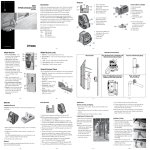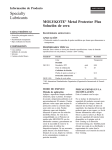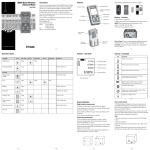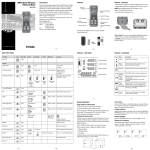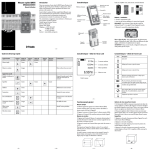Download Spectra AL24A User's Manual
Transcript
AL 24/28/32 - A/M Series Features Maintenance and Care Auto Levels User Guide • 1 13 2 12 3 4 5 11 10 6 9 7 01. Focusing knob 02. Sighting guide 03. Crosshairs’ adjustment screws (under cover) 04. Crosshairs’ focusing ring 05. Eyepiece 06. Horizontal rotation ring and angle index 07. Leveling screws 08. Base plate 09. Circular level adjustment screws 10. Horizontal tangent knob 11. Circular level 12. Mirror for reading circular level 13. Objective 8 • As with all precision instruments, the auto level should be transported and stored in its carrying case. • When carrying the instrument mounted to a tripod, be sure to carry it vertically rather than over your shoulder. • Whenever possible, store the instrument in a dry, shady area. • Wipe the instrument clean with a cloth. Clean the objective and eyepieces with special care using a damp tissue or soft, clean, lint-free cotton cloth. • When working in wet weather, wipe off the instrument and carrying case in the field and let them dry completely indoors with the case open. Safety Information Included in this manual are Cautions and Notes. Each of these words represents a level of danger or concern. A Caution indicates a hazard or unsafe practice that could result in minor injury or property damage. A Note indicates important information unrelated to safety. www.trimble.com –2– How to Use the Instrument Taking Measurements Setting Up the Instrument 1.Set up the tripod at a height appropriate for your use. Note: Make sure the tripod is stable and the tripod head is relatively level. 2.Attach the instrument to the tripod. 3.Level the instrument using the circular level as a reference. 4.Focus the telescope crosshairs by turning the crosshairs’ focusing ring. Determining the Difference in Elevation 1.259 B 0.467 –5– b1 a1 1.726 Aligning the Instrument 1.Align the telescope to the grade rod using the sighting guides. 2.Turn the focusing knob to bring the grade rod into sharp focus. Precisely sight the center of the grade rod in the telescope crosshairs using the horizontal tangent knob. 3.Check for parallax shift. Note: No parallax exists if the crosshairs and the grade rod graduations remain in coincidence even when you change your viewing angle (move your eye up/down and left/right in front of the eyepiece). Note: After the bubble in the circular level has been centered, the compensator corrects residual line-of-sight inclinations. The compensator does not, however, eliminate any tilts resulting from inadequate adjustment of the circular level or line of sight. These must be checked regularly (see Adjusting the Instrument for more information). –3– A Establishing an Elevation 1.Set up and level the instrument. 2.Set the grade rod on a known elevation (30.55 m) and take a grade rod reading (1.72 m). 3.Add the grade rod reading to the known elevation to get the height of instrument or HI (1.72 + 30.55 = 32.27 m). 4.Subtract the elevation of the point you want to establish (31.02 m) from the HI (32.27) to calculate the difference between the two points (32.27 – 31.02 =1.25 m). 5.Go to the point you want to establish and adjust the height of the grade rod until the calculated difference (1.25) is centered in the crosshairs. 1.Set up the instrument half way between two points (A and B). 2.Take a reading at point A (a1 = 1.726 m) and another one at point B (b1 =1.259 m). Note: A slight deviation of the line of sight from horizontal will not cause any measuring error as long as the instrument is set up approximately half way between the two points. 3.Subtract b1 from a1 to get the difference between the points (d = 0.467 m). Note: Point B is 0.467 higher than point A because the difference is a positive number. If point B were lower than point A, the number would be negative. –6– –4– Taking a Distance Measurement Note: The instrument’s stadia lines allow you to determine the distance between the instrument and the grade rod. 1.Take readings at the upper stadia 15 line (1.436 m) and the lower stadia 14 line (1.152 m). 2.Calculate the difference between 13 the two readings (1.436 – 1.152 = 12 0.284 m). 11 3.Multiply the difference by 100 to get the distance between the 10 instrument and the grade rod (.284 x 100 = 28.4). Computation Example Elevation Center Line Reading Distance Measurement Upper Stadia Line Reading Lower Stadia Line Reading Difference Distance (0.284 x 100) –7– 1.294 m 1.436 m 1.152 m 0.284 m 28. 4 m –8– Adjusting the Instrument Taking an Angle Measurement 1.Set up the tripod so that it is over a hub. Note: Make sure the tripod is stable and the tripod head is relatively level. 2.Hang a plumb-bob from the plumb-bob hook on the tripod. Note: Make sure the plumb-bob is over the hub. 3.Attach the instrument to the tripod. 4.Center the plumb-bob over the pin in the hub by varying the length of the tripod legs or by shifting the instrument on the tripod. 5.Accurately align the telescope to the first target using the sighting guides and a horizontal tangent knob. Note: The first target is a known point. 6.Set the horizontal rotation ring to 0. 7.Accurately align the telescope to the second target and read the angle. Circular Level 1.Set up the instrument. 2.Center the bubble of the circular level using the leveling screws. 3.Turn the telescope 180° (200 gon). 4 Check to see whether the bubble is still centered in the circle. If it isn’t, eliminate one half of the error with the leveling screws and the other half with the two adjustment screws for the circular level. 5.Repeat the process until the bubble remains centered when the instrument is turned. Line of Sight a2 b2 a1 b1 B A a2 = 2.423 +b1 = 0.936 d = +1.487 b2 = 1.462 -d = 1.487 c = 2.949 1.Set up the instrument half way between two points (A and B) that are 30 to 40 m apart. 2.Take a reading at point A (a1 = 2.423 m) and another one at point B (b1 = 0.936 m). 3.Subtract b1 from a1 to get the difference between the points (d = +1.487 m). Make sure you note whether value d is a positive or negative number. Note: Because the distance from the instrument to each of the points is equal, the difference in elevation is correct even if the line of sight is out of adjustment. –9– – 10 – Specifications 4.Move the instrument and reset it up so that it is about 2 m behind point B. 5.Take another reading at point B (b2 = 1.462 m). 6.Add b2 to d to get value c (1.462 + 1.487 = 2.949 m). 7.Take another reading at point A (a2). 8.Compare value c (2.949) to a2. If the line of sight is correct, both numbers should be the same. If they differ by more than 4 mm, reset the grade rod on point A and turn the crosshairs adjustment screws (unscrew the cover to expose them) until value c (2.949) is centered in the crosshairs. Caution: The upper and lower adjustment screws are counter-screws and must not be set too tightly. 9.Repeat the process until the line of sight is correct (c and a2 are the same). Notice to Our European Union Customers For product recycling instructions and more information, please go to: www.trimble.com/environment/summary.html Recycling in Europe To recycle Trimble WEEE, call: +31 497 53 2430, and ask for the ÒWEEE associate,Ó or mail a request for recycling instructions to: Trimble Europe BV c/o Menlo Worldwide Logistics Meerheide 45 5521 DZ Eersel, NL – 11 – – 12 – Service Request Dimensions (L x W x H) Instrument Case Weight Instrument Case Accuracy Standard deviation according to DIN 18723 on 1 km of double leveling Leveling accuracy Telescope Magnification Aperture Telescope image Field of view angle Shortest focusing distance Stadia constant Addition constant Automatic Compensator Type AL2XA, AL32A AL2XM (-G) – 13 – AL24A / AL24M AL28A / AL28M / AL28M-G AL32A 130 x 190 x 135 mm (5.1 x 7.5 x 5.3 in.) 170 x 280 x 190 mm (6.7 x 11.0 x 7.5 in.) 130 x 190 x 135 mm (5.1 x 7.5 x 5.3 in.) 170 x 280 x 190 mm (6.7 x 11.0 x 7.5 in.) 130 x 190 x 135 mm (5.1 x 7.5 x 5.3 in.) 170 x 280 x 190 mm (6.7 x 11.0 x 7.5 in.) 1.6 kg (3.5 lb) 1.25 kg (2.75 lb) 1.6 kg (3.5 lb) 1.25 kg (2.75 lb) 1.6 kg (3.5 lb) 1.25 kg (2.75 lb) +/–2.0 mm +/–1.5 mm +/–1.0 mm 3 mm @ 46 m (1/8 in. @ 150 ft) 1.5 mm @ 60 m (1/16 in. @ 200 ft) 1.5 mm @ 75 (1/16 in. @ 250 ft m) 24x 30 mm (1.2 in.) Erect 1° 20' 0.60 m (1.97 ft) 100 0 28x 30 mm (1.2 in.) Erect 1° 20' 0.60 m (1.97 ft) 100 0 32X 36 mm (1.4 in.) Erect 1° 20' 0.60 m (1.97 ft) 100 0 Wire suspension: Air damped Magnetic damped Wire suspension: Air damped Magnetic damped Wire suspension: Air damped To locate your local dealer or authorized Trimble Service Center outside the U.S.A for service, accessories, or spare parts, contact one of our offices listed below. North-Latin America Trimble Construction Tools Division 8261 State Route 235 Dayton, Ohio 45424-6383 U.S.A. (800) 538-7800 (Toll Free in U.S.A.) +1-937-245-5600 Phone +1-937-233-9004 Fax www.trimble.com Asia-Pacific Trimble Navigation Singapore PTE Ltd. 80 Marine Parade Road, #22-06 Parkway Parade Singapore, 449269 +65 6348 2212 Phone +65 6348 2232 Fax Africa & Middle East Trimble Export Middle-East P.O. Box 17760 JAFZ View, Dubai UAE +971-4-881-3005 Phone +971-4-881-3007 Fax China Trimble Beijing Room 2805-07, Tengda Plaza, No. 168 Xiwai Street Haidian District Beijing, China 100044 +86 10 8857 7575 Phone +86 10 8857 7161 Fax www.trimble.com.cn Trimble Construction Tools Division 8261 State Route 235 Dayton, Ohio 45424-6383 U.S.A. +1-937-245-5600 Phone Europe Trimble GmbH Am Prime Parc 11 65479 Raunheim GERMANY +49-6142-2100-0 Phone +49-6142-2100-550 Fax www.trimble.com N324 – 14 – – 15 – © 2010, Trimble Navigation Limited. All rights reserved. Reorder PN 1211-0151B (05/10)


